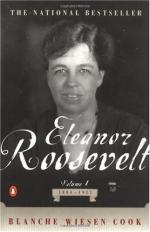|
This section contains 711 words (approx. 2 pages at 400 words per page) |

|
Feminism
Cook began her research for Eleanor Roosevelt in the early 1980s. By that time, the modern women's movement was entering its third decade. It had begun in the early 1960s, with the publication of Betty Friedan's best-selling book, The Feminine Mystique in 1963, and gathered strength from the formation of the National Organization for Women (NOW) in 1966. One of the goals of NOW was to end sex discrimination. The time was right since a 1964 report of the President's Commission on the Status of Women (PCSW) documented pervasive discrimination against women. (The original chair of the PCSW, which was set up in 1961, was Eleanor Roosevelt.) Even though Title VII of the Civil Rights Act of 1964 banned sex discrimination there was still much work to be done in that area.
During the 1970s, NOW began to pursue a more radical agenda, advocating not only equal pay, equal rights, abortion rights...
|
This section contains 711 words (approx. 2 pages at 400 words per page) |

|




